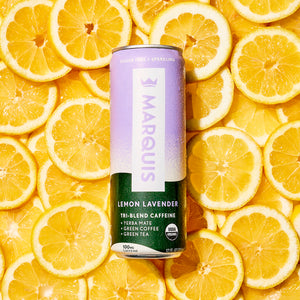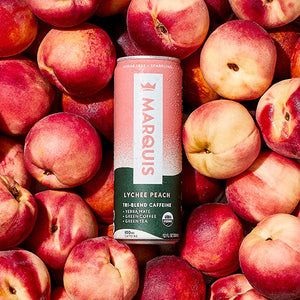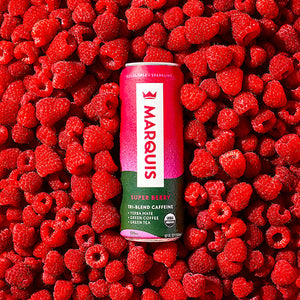
10 min read
The morning caffeine burst is a ritual for many people. We can't start our days without it and rely on caffeine to get us through the afternoon slump. It's an incredibly important aspect of our lives, and it's essential to know the healthiest ways to get your caffeine kick and how much you should consume.
Caffeine is a natural stimulant and is one of the most common ingredients in the world. The world has consumed tea and coffee for centuries, but it wasn’t until the 1800s when caffeinated soft drinks and energy drinks hit the market (adding more sugar and preservatives).
Although there are many benefits to caffeine, many of our favorite caffeinated drinks such as coffee, energy drinks, and tea may contain too much caffeine. Yes, “too much caffeine” is a thing!

How It Works
Caffeine works by being absorbed from the gut into the bloodstream. It travels to the liver and is then broken down into compounds that directly affect specific organs' functions. However, caffeine mainly affects the brain. It does this by blocking the effects of adenosine (a neurotransmitter that relaxes the mind and makes you feel tired).
Caffeine makes you stay awake by connecting to adenosine receptors in the brain without actually activating them. This boost to the brain stimulates alertness and focus. You can feel the desired effects of caffeine quickly, in as little as 20 minutes to reach the bloodstream, while one hour to feel the full impact.
Caffeine Benefits
We all love the energizing effects of caffeine, and luckily there are some great benefits to it as well. With over 90 percent of North American adults relying on it each day, we've outlined some of our favorite reasons to consume caffeine.
- Caffeine can improve mood and brain function, causing an increase in signaling molecules such as dopamine and norepinephrine (the chemical messengers that can boost your mood). Along with this, caffeine can provide alertness and short-term recall.
- Metabolism- Since caffeine can stimulate the nervous system, it also has been shown to increase metabolism. Although the studies show that the effects are likely small and happen over time, we all love to know that caffeine can help us live a healthy lifestyle.
- Better exercise- Along with your metabolism, caffeine can affect your exercise performance. Studies show that fat-burning increased when individuals consumed caffeine before working out.
It's important to note that caffeine affects everyone differently. Some people can drink a lot throughout the day and feel little to no side effects, while others can feel spikes of blood pressure, headaches, anxiety, and more from just a little bit of caffeine.
How Much Caffeine is Too Much
We get it. We all rely on caffeine to get us through our day.
Up to 400 milligrams of caffeine, a day for most adults is recommended. In real-life terms, this means a rough estimate of around four steaming cups of joe, ten cans of soda, or two "energy shots"... but who wants to drink ten cans of soda?
Be wary of caffeine in powder form. The U.S. Food and Drug Administration (FDA) warned that this could provide toxic amounts of caffeine. Just one teaspoon of powdered caffeine is equivalent to about 28 cups of coffee. Such high levels of caffeine can cause serious health problems.
Research is growing regarding the correlation between caffeine and health. However, here are the most common side effects when too much caffeine is consumed:
- Headache
- Insomnia
- Nervousness
- Irritability
- Frequent urination or inability to control urination
- Fast heartbeat
- Muscle tremors
None of us want caffeine's adverse side effects, but we still need something to get us through our day. That's why we created Marquis. Each can of Marquis contains 100 milligrams of plant-based organic caffeine. Each morning, we get out of bed excited by the task at hand, taking the best ingredients planet Earth has to offer and squeezing them into every can.
Green Tea Caffeine
Why green tea? While both green and black tea are products of the Camellia-sinensis plant, they are very different ingredients. Black tea is very commonly used. It's produced by crushing the plant's leaves before leaving them to oxidize. During this oxidization, many of the antioxidants, micronutrients, and vitamins inherent to the plant are broken down. Why waste all these nutrients! We choose green tea because it skips this step.
Drying the leaves whole preserves their integrity - producing green tea. This more straightforward path retains the plant's numerous health benefits. The micronutrients in the green leaf help lower cholesterol and your chance of having a stroke or a heart attack while at the same time boosting your cognitive function, immune system, and metabolism.
Green Coffee Caffeine
Coffee beans are grown everywhere, and most often than not, they are picked and dry in the sun, turning from green to brown under the heat. Most of the beans then head to coffee shops. However, we are interested in the green beans, for one reason only- chlorogenic acid.
Chlorogenic acid possesses natural health and wellness qualities- making it our super-star ingredient. As an antioxidant, it supports liver, heart, and brain function; exhibits an anti-diabetic effect, and actively fights against cancer cells' formation. It’s also scientifically proven to help assist with weight-loss and keep blood pressure low. Slam dunk for green coffee!
Yerba Mate Caffeine
Yerba mate, a.k.a. "drink of the gods," is another key ingredient of Marquis. It's a traditional South American tea used for its nutrient-dense qualities and powerful caffeine kick. It includes 15 different amino acids, Vitamin B, Vitamin C, Zinc, Potassium, Magnesium, and a range of Antioxidants. What more could you want in your caffeine source?

Marquis
Marquis’ caffeine blend is naturally derived from three plant-based ingredients: Yerba Mate, Green Coffee, and Green Tea. These ingredients are all about the non-jittery, sustainable energy you need.
We've proved why each of our organic ingredients is key for Marquis. We are setting the standard for caffeine drinks around the world.
Sources
https://pubmed.ncbi.nlm.nih.gov/723503/































